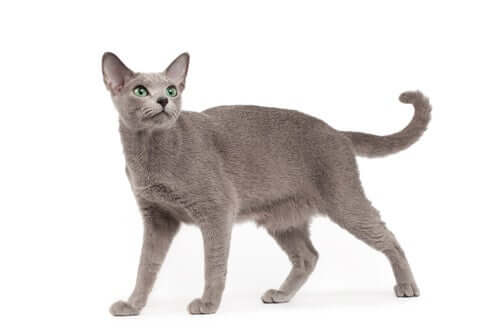Cat Tail Language - How to Understand Your Cat

Cat tail language is just one part of their complex body language. You can get a lot of information about their mood and intentions just by looking at them, as well as their positions and the way they move. Pay special attention to what they do with their tail; it’ll help you better understand them.
You’re probably familiar with the way dogs wag their tails as they express their emotions. But cat’s tails are completely different as they’re sort of polar opposites. For instance, a feline will try to hide their emotions so it’ll be difficult to know if they’re sick or in pain.
Cat tail language – the information it provides
The information you can obtain by watching your cat’s tail is very important. It’ll ease your coexistence with them and will make it more pleasant for all involved. Each animal has a different personality, but there are a number of tail positions they have in common. So, if you know how to interpret them, then you’ll avoid a few scratches or even a bite.

Straight up tail: When a cat’s tail goes into an upright position, this is a clear sign they feel safe wherever they are. It’s always a positive message. Also, if they make very slow and progressive movements with the tip while keeping the tail in this position, it means they’re also happy.
Vertical and vibrant: When a cat’s tail is up but makes vibrant, fast movements, then it means they’re happy and excited. This is something they usually do when we get home or when they watch us making a meal. In contrast, males also do this type of move when they’re about to urinate and mark their territory.
Contrasting signs
Curved: A cat with a curved tail in the form of “S” is a good sign. It usually means they want to play or get your attention. Commonly, the most dependent and playful cats will maintain it this way throughout the day as they request more touching from you. They do this either out of boredom or mere self-confidence. It’s uncommon to see the tail in this position in suspicious animals, although many of them could get better and more confident as time goes by.
Fast sideways movements: When a cat does these moves, it’s because they’re feeling uncomfortable. Either you’re bothering them or rubbing a very sensitive area of their bodies, such as their belly or pads. You must be alert when they do this type of move because they’re about to scratch you — unless you stop what you’re doing, that is.

Down and stiff: This is the worst signal you can receive from your cat’s tail. It means they’re angry and very likely to attack you if you don’t back off and give them space. When they hold their tail in this position they’re also vocal about it. However, there are cats who aren’t so obvious with their warnings and might attack you unexpectedly.
Feeling scared
Tail between the legs: This is the posture that most resembles a dog. It’s usually a cat’s reaction to a situation that either makes them anxious or scares them. For example, house removals are usually highly traumatic for cats and they might be upset for a few days. This tail position doesn’t usually involve aggressive behavior though. Their most common instinct is to run away. So, give them some time and space.
Rolled up: When a cat keeps their tail in this position, either while they sleep or during a relaxing activity, it only means they’re quite comfortable and happy. This is usually accompanied by a pleasant purr and is an unequivocal sign that you’re doing things right by them.
Learning cat tail language will allow you to anticipate any problems your pet might have. Also, you’ll be able to assess their mood or whether they’re afflicted by some kind of ailment. Understanding your animal is essential for you both to enjoy each other without any issues.
All cited sources were thoroughly reviewed by our team to ensure their quality, reliability, currency, and validity. The bibliography of this article was considered reliable and of academic or scientific accuracy.
- Etolia. El lenguaje corporal de los gatos. 11 de julio de 2011. Extraído de: http://www.etologiaveterinaria.net/el-lenguaje-corporal-de-los-gatos/
- Experto animal. El lenguaje corporal de los gatos. 18 de julio de 2019. Extraído de: https://www.expertoanimal.com/el-lenguaje-corporal-de-los-gatos-3148.html
- Hillspet. Lo que la cola de tu gato dice sobre él. 3 de julio de 2019. Extraído de: https://www.hillspet.es/cat-care/behavior-appearance/cat-tail-language
This text is provided for informational purposes only and does not replace consultation with a professional. If in doubt, consult your specialist.